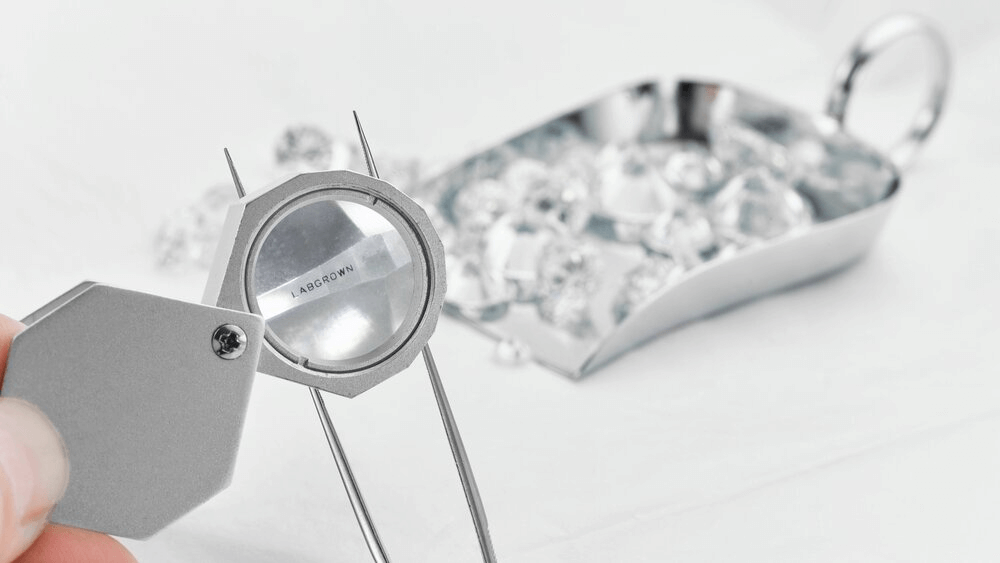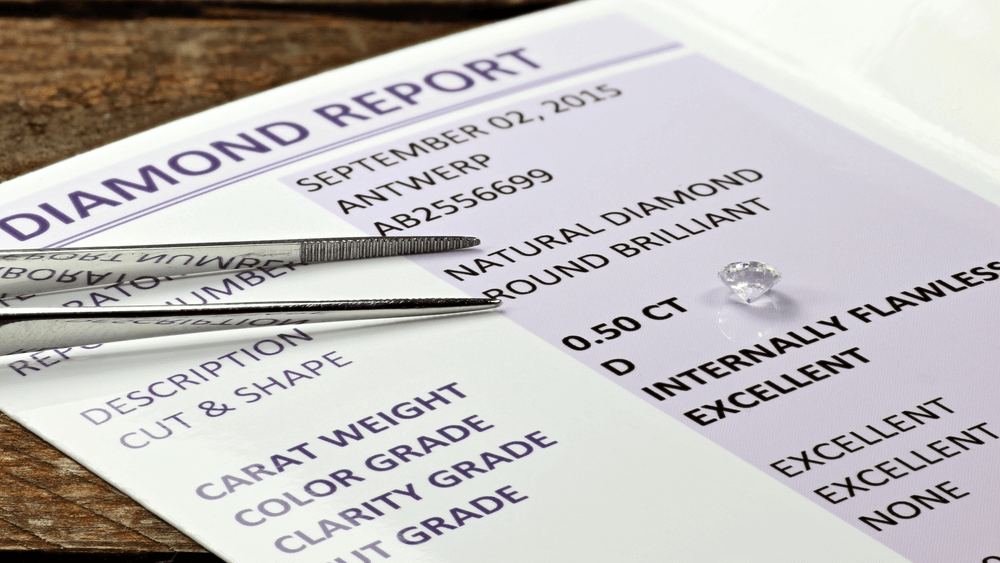GCAL vs GIA Diamond Certification: Make an Informed Choice!

By Gary A.

Edited by Olivia H.
Published Aug 13, 2024
Edited on Dec 18, 2024
Is the GCAL certification a suitable substitute for the GIA? Read on to find out…

Navigate this guide:
- 10 Quick Tips for GCAL Certification for Diamond Engagement Rings
- Introduction to Diamond Certifications
- Understanding GCAL Certification
- GIA: The Benchmark of Diamond Quality
- GCAL vs GIA: A Comparative Analysis
- Ethical Considerations in Diamond Sourcing
- Our Expert Take
- 7 Frequently Asked Questions about GCAL Certification
Before we dive deeper into the specifics of GCAL certification, here are some practical tips to help guide your decision-making process.
10 Quick Tips for GCAL Certification for Diamond Engagement Rings
When exploring diamond engagement rings, understanding GCAL certification can provide deeper insights into your selection. Here’s a combined list of key features and practical tips to consider:
Tip 1: Verify GCAL Certificate Authenticity
- Always confirm the authenticity of the GCAL certificate. Cross-reference the certificate number with the inscription on the diamond and GCAL’s online database.
Tip 2: In-Depth Analysis of the 4Cs
- Examine the 4Cs (Cut, Color, Clarity, Carat) on the GCAL certificate. Understand GCAL’s unique grading approach, especially for clarity and color, to gauge the diamond’s quality accurately.
Tip 3: GCAL’s Comprehensive Cut Grading
- GCAL’s detailed cut grading system assesses aspects like polish, symmetry, optical brilliance, and fire. This provides a nuanced view of the diamond’s cut quality, crucial for its sparkle and overall appeal.
Tip 4: Optical Brilliance and Fire Analysis
- GCAL’s Optical Brilliance Analysis measures the return of bright, white light. Evaluate this feature to understand the diamond’s interaction with light and its visual impact.
Tip 5: Proportions Matter
- Review the diamond’s proportions as indicated in the GCAL certificate. Ideal proportions are key to the diamond’s brilliance and overall aesthetic.
Tip 6: Unique Features of GCAL
- GCAL offers innovative features like Gemprint and Optical Brilliance Analysis. These provide additional insights into the diamond’s unique characteristics.
Tip 7: Lab-Grown Diamond Reports by GCAL
- If considering lab-grown diamonds, GCAL’s detailed grading reports, including light performance and hearts and arrows, offer comprehensive analysis.
Tip 8: Traceability with GCAL and Sarine
- GCAL’s partnership with Sarine offers Diamond Journey traceability, crucial for buyers focused on ethical sourcing and diamond origin.
Tip 9: GCAL’s Consumer Guarantee
- GCAL’s unique consumer guarantee, including a money-back promise, offers additional assurance and peace of mind.
Tip 10: GIA’s Established Credibility and Resale Advantage of the GIA-Certified Diamonds
- For future resale considerations, GIA-certified diamonds typically have higher resale values due to the global trust and credibility associated with GIA.
- Remember the global recognition of GIA. Their grading system, especially the 4Cs, is an industry standard, known for its consistency and reliability.
Now that you’ve got these practical tips, use Jeweler AI below to find the perfect engagement ring that suits your style and budget:
Introduction to Diamond Certifications
When embarking on the journey to find the perfect diamond, understanding certifications is crucial. These documents serve as a diamond’s passport, detailing its unique characteristics and quality. In a market where trust is paramount, certifications provide an objective assessment of a diamond’s value, ensuring that buyers can make informed decisions.
The Importance of Trust in Your Diamond Choice
Trust forms the foundation of any significant purchase, and diamonds are no exception. With their high value and emotional significance, it’s essential to have confidence in what you’re buying. Diamond certifications offer this assurance, providing an unbiased evaluation of a stone’s qualities. They bridge the gap between sellers and buyers, creating a common language of diamond quality that transcends geographical boundaries and individual interpretations.
Understanding GCAL Certification
The Gem Certification & Assurance Lab (GCAL) has carved out a niche in the diamond certification landscape, offering a unique approach to diamond grading and documentation.
The Genesis of GCAL
Founded in 2001, GCAL emerged as an alternative to traditional certification methods. The lab positioned itself as a technologically advanced option, emphasizing precision and consistency in its grading process.
Unique Features of GCAL Certification
GCAL’s certification process includes several distinctive elements. They offer a Gemprint® registration, which creates a unique optical fingerprint for each diamond. This feature aids in diamond identification and theft prevention. GCAL also provides a performance analysis, assessing a diamond’s light performance and optical symmetry.
GCAL’s Approach to Lab-Grown Diamonds
In recent years, GCAL has gained attention for its certification of lab-grown diamonds. They offer specialized reports for these synthetic stones, providing detailed information about their growth process and characteristics. This approach has contributed to increased transparency in the lab-grown diamond market.
GIA: The Benchmark of Diamond Quality
The Gemological Institute of America (GIA) stands as the gold standard in diamond certification, recognized globally for its rigorous standards and unparalleled expertise.
GIA’s Legacy and Global Recognition
Established in 1931, GIA has been at the forefront of gemological research and education for nearly a century. Its contributions to the field, including the development of the International Diamond Grading System™ and the 4Cs of diamond quality, have shaped the entire industry. GIA’s reputation for integrity and consistency has made its certificates the most widely accepted and trusted in the world.
GIA’s 4Cs: The Universal Language of Diamond Quality
GIA’s introduction of the 4Cs – Cut, Color, Clarity, and Carat Weight – revolutionized diamond grading. This system provides a standardized method for evaluating diamond quality, enabling clear communication between industry professionals and consumers alike. GIA’s grading scales for each of these characteristics are considered the most comprehensive and precise in the industry.
Why GIA Certification Matters
A GIA certificate offers unparalleled assurance of a diamond’s quality. The institute’s stringent grading process, coupled with its commitment to ongoing research and education, ensures that each GIA-certified diamond has been evaluated to the highest standards. For buyers, this translates to confidence in their purchase and the ability to make well-informed decisions based on accurate, reliable information.
GCAL vs GIA: A Comparative Analysis
While both GCAL and GIA provide diamond certifications, their approaches and industry standing differ significantly.
Methodologies Compared
GIA’s grading process is widely regarded as the industry standard, characterized by its consistency and rigorous methodology. GCAL, on the other hand, emphasizes technological solutions and offers additional features like the Gemprint® registration. While GCAL’s approach has its merits, particularly in areas like light performance analysis, GIA’s traditional methodology remains the most trusted and widely recognized in the industry.
Consumer Perception and Market Impact
GIA certificates are universally accepted and often preferred by consumers and industry professionals alike. This widespread recognition can significantly impact a diamond’s marketability and resale value. GCAL, while gaining traction, particularly in the lab-grown diamond sector, does not yet command the same level of global recognition or market impact as GIA.
Ethical Considerations in Diamond Sourcing
The diamond industry has increasingly focused on ethical sourcing practices, reflecting growing consumer awareness and demand for responsibly sourced gems.
The Role of Ethical Sourcing
Ethical sourcing ensures that diamonds are obtained through legitimate, environmentally responsible, and conflict-free means. This consideration has become crucial for many buyers, who seek assurance that their purchase does not contribute to harmful practices or environmental degradation.
GCAL’s and GIA’s Stance on Sustainability
Both GCAL and GIA have taken steps to address ethical concerns in the diamond industry. GIA, with its global influence, has been at the forefront of promoting transparency and ethical practices. The institute offers courses on sustainability and has implemented programs to support responsible sourcing. GCAL, while less prominent in this area, has shown commitment to sustainability through its support for lab-grown diamonds, which are often marketed as a more ethical alternative to mined stones.
Our Expert Take
Choosing a diamond is a deeply personal decision, one that combines emotional significance with practical considerations. Understanding certifications, particularly the differences between GCAL and GIA, empowers you to make an informed choice. While GCAL offers some innovative features, GIA’s long-standing reputation and global recognition make it the preferred choice for many buyers seeking assurance of their diamond’s quality. Ultimately, the best choice is one that aligns with your values, budget, and personal preferences, supported by a trusted certification that gives you confidence in your investment.
7 Frequently Asked Questions about GCAL Certification
- Q : What is GCAL Certification?
- A: GCAL certification is a comprehensive evaluation provided by the Gem Certification & Assurance Lab, focusing on the quality, authenticity, and detailed characteristics of diamonds, including lab-grown varieties.
- Q : How Does GCAL Certification Compare to GIA?
- A: While both GCAL and GIA offer rigorous diamond grading, GCAL is known for its unique features like direct assessment of optical brilliance and Gemprint technology. GIA, on the other hand, is renowned for establishing the 4Cs grading system and its global recognition.
- Q : Can GCAL Certify Lab-Grown Diamonds?
- A: Yes, GCAL provides detailed grading reports for lab-grown diamonds, assessing them with the same strict standards applied to natural diamonds, including light performance and optical symmetry.
- Q : How Can I Verify a GCAL Certificate?
- A: You can verify a GCAL certificate by cross-referencing the certificate number with the inscription on the diamond and checking it against GCAL’s online database for authenticity.
- Q : What Makes GCAL’s Optical Brilliance Analysis Unique?
- GCAL’s Optical Brilliance Analysis is a proprietary method that measures the return of bright, white light from a diamond, offering a direct assessment of its optical performance and visual impact.
- Q : Does GCAL Offer a Consumer Guarantee?
- Yes, GCAL provides a unique consumer guarantee, including a money-back promise, which offers buyers additional assurance and peace of mind regarding their diamond purchase.
- Q : Is a GCAL Certification as Recognized as GIA?
- A: While GIA is globally recognized and often considered the gold standard in diamond certification, GCAL is highly respected for its technological innovations and detailed grading reports, especially among those prioritizing optical qualities and ethical sourcing.
Discover your perfect diamond with Jeweler AI. Dive into the world of GCAL certification today
FOLLOW-UP GUIDE SERIES







